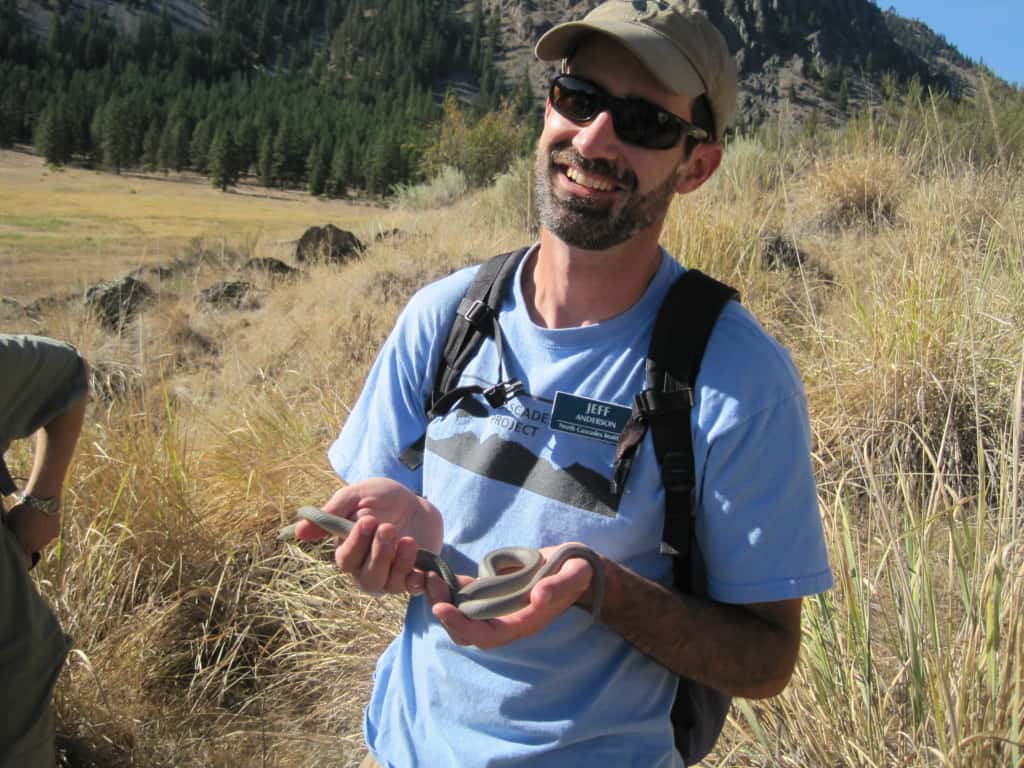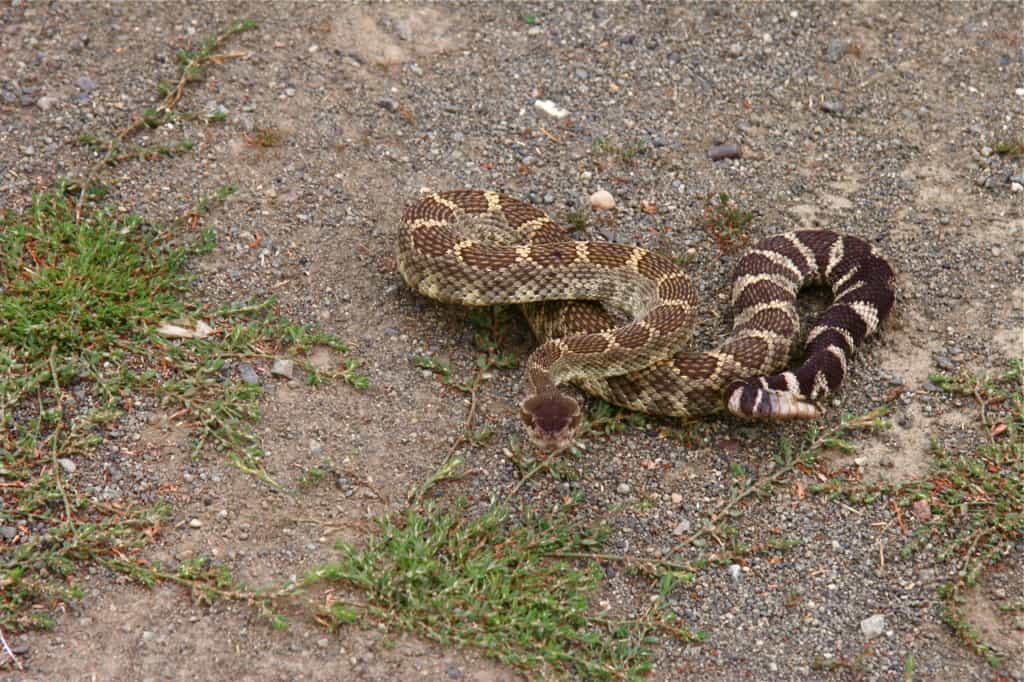
Searching For Snakes in the Methow Valley
Even before we leave the parking lot, someone has spotted a snake. Luke, eleven years old and the youngest student in our class, had been looking through his binoculars at a tall shrub at the Methow Valley Ranger Station in Winthrop, Washington. When he announces, “There’s one!” we all run over and find a racer, a common snake that lives up to its name. The animal nearly disappears but for the quick hands of another student. Scott Fitkin, a wildlife biologist with the Washington Department of Fish & Wildlife (WDFW), praises the move with a warning.

“That’s great,” he says, holding the snake, “but you always want to make very sure of the species you’re reaching for.” In a landscape where rattlesnakes are also common, such words are sound advice, but even racers will bite. The snake’s solid coloration includes olive green above and lemon yellow below. “Go slowly, go gently, and move with the scales,” instructs Scott on the proper method for holding a snake that will keep traveling as it’s being held.
Gathering closer to admire the racer, we listen to Scott and John Rohrer, a biologist with the Okanogan-Wenatchee National Forest, talk about snakes. They are the instructors for the “Spring Snake Search,” a one-day environmental education class sponsored by North Cascades Institute (NCI). The event is designed to show how fascinating and “even personable” snakes are, as well as to demonstrate their important roles in the ecosystem. We will visit different nearby areas that are known to have snakes present, including racers, rattlesnakes, garter snakes, and the very secretive rubber boas. The focus will be on reptiles, but we’ll also be near ponds, good places to find amphibians.
*
This May morning in the Methow Valley of eastern Washington is already warm. We don’t see many reptiles before a young woman spots a gopher snake in the shade of a sagebrush clump. Gopher snakes are constrictors, so they’re not venomous and are safe to pick up. Scott, who has been a snake enthusiast since before he can remember, explains that they will imitate a rattlesnake, however, to appear more menacing to would-be predators. “A gopher snake will vibrate its tail and hiss,” he says. “But they also settle pretty quickly and don’t mind being handled for short periods.”
The dark markings on the animal’s back are ragged diamond shapes, further increasing its similarity to a rattlesnake. This individual has recently shed its skin, so it’s particularly shiny and attractive. Scott and John tell us that gopher snakes are good “ambassador” animals, the dictionary definition of which is an “official herald, messenger, or agent with a special mission.” There is no way of knowing what this snake thinks of the idea that its species can function as a connector between humans and reptiles, but it doesn’t appear stressed. The handling, the strange beings all around it, the foreign smells, elicit only an occasional flick of its tongue. We return the snake to the sagebrush and it moves off silently into the shade.
The Spring Snake Search class began in 2012. Katie Roloson, then program manager for NCI’s field classes, had met Scott and John when they taught a class on carnivores for the Institute. Roloson knew that they felt sharing their work was an important part of their jobs. At the same time, NCI, with its goal of educating and connecting people to the natural world, had a real interest in citizen science and getting more people interacting with biologists.
Working together was a “win-win,” Katie told me. Scott and John agreed to provide the expertise and leadership for the class; NCI would manage funding and logistics. Some NCI staffers worried that a class with snakes as a theme wouldn’t be popular, but after its first year, the concerns disappeared. “It filled and participants loved it,” Katie shared. “It also brought in a crowd that might not take other classes we offered.”
*
The morning passes and soon it is lunchtime. Though ectothermic, meaning they rely on warm surfaces or air temperatures to heat themselves, snakes can also find a sunny, spring day too hot. We’ve observed only a handful of gophers as well as the racer; if the snakes have messages for us today, they are keeping the communications to themselves.
The big challenge with this class is always the timing. “You have to be in the right place, at the right time, with the right weather to be able to find a lot of snakes,” John says. During the first couple of years, they did both spring and fall classes, but a full season’s worth of grass and forb growth made it hard to see the animals in the autumn. Even in the spring, environmental conditions might not be ideal. As a backup, the focus sometimes switches to amphibians, which are more active in warm, rainy conditions.
Soon we’re exploring a shadier area adjacent a wetland. Robin, a young woman from western Washington, who is doing the class for the fourth time, spots a small rattlesnake on top of a stump.
As Washington’s only venomous species, rattlesnakes can potentially inflict damage if they should bite. For this reason, both John and Scott carry “snake sticks.” These long, aluminum poles have a clamp on the end that can be opened and closed to fit around a snake’s body. Once a rattlesnake is held with the clamp, it can then be coaxed into a plastic tube where its mouth and head will remain safely out of reach, while the lower parts of its body, including the tail and rattle, can be admired or measured for data collection.
Robin’s snake is a young one, born late last summer and less than two feet long. It has only one segment, also called a button, comprising its rattle. Though it vibrates its tail, without additional segments for the button to rub against there is no sound. When returned to the stump, the snake’s uneven, chocolate-colored pattern blends in well with the chunks of decomposing wood.
*
John Rohrer, like Scott Fitkin, has always been interested in snakes. As a boy growing up in northwestern Arizona, he kept a few lizards and snakes in cages though his parents didn’t allow him to keep rattlesnakes. Instilling similar curiosity in other people is what the Spring Snake Search is all about. The two men have been teaching the class since 2011 and their goals are simple: to lessen the fears around snakes, correct misperceptions, help people appreciate these important animals, and collect data. John has seen positive changes over the years in terms of society’s view of these animals.
“Education is the key,” he says. “I definitely think there are fewer people, compared to 25 years ago, that kill rattlesnakes just to kill them.” Scott agrees, adding that changing people’s minds is helped immensely if they can see the snakes up close in a controlled situation. Though some people in our group don’t want to hold the snakes, everyone at least touches the tail of the rattlesnake.
*
The Golden Doe Wildlife Area is a 1,500 acre of land managed by WDFW. It was acquired by the department in 1991 from a private individual, who had hoped to make a success of a working ranch but found the land to be too “snake-y.” One of our stops on the property is the “concrete castle,” a name ascribed by John to the abandoned cement foundations of a dwelling that was never finished.
“The building crew kept coming across so many rattlesnakes,” he explains, “that they eventually refused to come back. My guess is that they unknowingly excavated a den site during the summer. Then all the snakes started showing up in September looking for their winter home. The workers were likely killing rattlesnakes every day, but then more would turn up the next day.”
Even after thoroughly searching among the concrete walls and piles of rubble, we find nothing beyond one black widow spider guarding her egg sac.
As we begin the hike back, John spots an adult rattlesnake in the tall grasses of a shady, aspen grove. With Scott’s assistance, John coaxes the snake into the tube. I get to hold her, using one hand to support and hold her body where it enters the tube, so that she doesn’t keep going, and the other hand to keep track of the tail area. This snake has six segments to her rattle, and the rattling sounds like a soft purr.
People ask questions about what happens to snakes when wildfires occur, a common event in the Methow Valley. John tells us that if the snakes are near rocks when the fire comes through, they can get to cover and survive in the cooler, protected area that also won’t burn. If they’re caught out in the open country, they usually don’t make it.
When all who want to have held the rattlesnake, we place her and the tube on the ground. After a few moments, the snake, rattling occasionally, slides through the tube and back into the tall grass.
*
Contrary to popular mythology, human fear of snakes isn’t instinctual. In many cultures, snakes have been revered, as symbols of transformation, rebirth, or fertility. They are wise and possess healing powers; they may act as messengers, either of cunning and trickery, as Christianity teaches, or of simple communication between different worlds. The sheer “otherness” of these animals must be the catalyst behind both humanity’s adoration and antagonism. Scott says he’s not entirely sure why he’s so drawn to snakes, but “perhaps it’s because they’re so different from us and so accessible.” This last point is important. That snakes can be found readily, caught, and observed up close, all means that a relationship, based on respect and admiration, rather than fear and dominance, is possible.
By pairing NCI’s environmental education infrastructure with John and Scott’s expertise, the Spring Snake Search has succeeded in its goals of educating the public about snakes. More than 80 people since 2012 have attended the class. John, Scott, and Katie all have stories about people uncertain, even afraid, of snakes before signing up. One of Katie’s co-workers at NCI was fearful, but when her mother wanted to take the class, she attended as well. “When she found a rattlesnake and got to hold it in the tube,” Katie told me, “she was simultaneously horrified and elated.”
That experience isn’t unusual. Scott said that two of his relatives attended a search, both moving “from fear to guarded fascination.” It is John and Scott’s passion and in-depth knowledge, as well as their ability to engage the natural curiosity of people, that makes the snake class so successful. Their enthusiasm for finding snakes and their calmness around the animals instills the same in others.
Later in the day, I hold a gopher snake and it flicks its tongue and explores along my forearm. Despite our shared moment together, this gopher snake’s understanding of existence contrasts so greatly from mine that I wonder if her message is simply about the value in being different. And that by accepting this value, empathy and compassion necessarily grow, blossoming into a belief that we all contribute, and that we all ultimately help each other to survive, whether we are snakes, or humans, or one of the millions of other species living on the planet.
*


I truly appreciate your good job you are doing on educating the public on snakes.
I had a small garter snake right off my patio last year! Saw it several times but haven’t seen hide nor skin of it this year! Dang it!
I live below the Golden Doe. All of the rattle snakes we have are no less than 9 buttons. And always make themselves known
I love snakes and I am glad you do too! 🙂